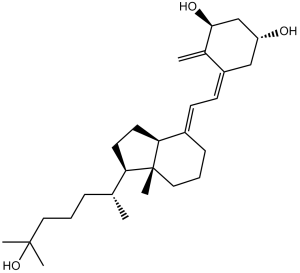Calcitriol (1,25-Dihydroxyvitamin D3)
This product is for research use only, not for human use. We do not sell to patients.

For small sizes, please check our retail website as below: www.invivochem.com
| Size | Price | Stock |
|---|---|---|
| 100mg | $850 | Check With Us |
| 200mg | $1275 | Check With Us |
| 500mg | $2155 | Check With Us |
Cat #: V1857 CAS #: 32222-06-3 Purity ≥ 98%
Description: Calcitriol (RO215535, Topitriol; 1,25(OH)2D3) is the metabolically/hormonally active form of vitamin D and a vitamin D receptor (VDR) agonist.
Top Publications Citing Invivochem Products
Publications Citing InvivoChem Products
Product Promise

- Physicochemical and Storage Information
- Protocol
- Related Biological Data
- Stock Solution Preparation
- Quality Control Documentation
| Molecular Weight (MW) | 416.64 |
|---|---|
| Molecular Formula | C27H44O3 |
| CAS No. | 32222-06-3 |
| Storage | -20℃ for 3 years in powder formr |
| -80℃ for 2 years in solvent | |
| Solubility In Vitro | DMSO: 83 mg/mL (199.2 mM)r |
| Water: <1 mg/mLr | |
| Ethanol: 83 mg/mL (199.2 mM) | |
| SMILES Code | C[C@@H]([C@H]1CC[C@H]2/C(CCC[C@]12C)=C/C=C3C[C@H](C[C@@H](C/3=C)O)O)CCCC(C)(O)C |
| Synonyms | 1,25(OH)2D3; 1,25(OH)2-D3; 1,25(OH)2-VD3; 1,25-Dihydroxyvitamin D3; RO215535, Topitriol; Rocaltrol; Calcijex; Topitriol; Silkis; Soltriol; 1α,25-Dihydroxyvitamin D3; 1α,25(OH)2D3 |
| Protocol | In Vitro | Calcitriol exerts antiproliferative effects on cervical cancer cells in vitro. Cells decrease by 12.8% when treated with 100 nM Calcitriol for 6 days, compare with control. Inhibition of cell proliferation becomes more pronounced with the increase in Calcitriol concentration. The decrease is 26.1% and 31.6% for 200 and 500 nM Calcitriol, respectively. Treatment with Calcitriol for 72 h induces an evident accumulation of cells in the G1 phase, with approximately 66.18% in 200 nM and 78.10% in 500 nM, compare with the control (24.36%). Calcitriol treatment significantly decreases HCCR-1 protein expression compare with the control in a time- and dose-dependent manner. |
|---|---|---|
| In Vivo | Chronic treatment with Calcitriol (150 ng/kg per day for 4.5 months) improves the relaxations (pD2: 6.30±0.09, Emax: 68.6±3.9% in Calcitriol-treated OVX, n=8). Renal blood flow in OVX rats is reduced in both kidneys, and the flow is restored by Calcitriol treatment. The increased expression of COX-2 and Thromboxane-prostanoid (TP) receptor in OVX rat renal arteries is reduced by chronic calcitriol administration. |
These protocols are for reference only. InvivoChem does not
independently validate these methods.
| Solvent volume to be added | Mass (the weight of a compound) | |||
|---|---|---|---|---|
| Mother liquor concentration | 1mg | 5mg | 10mg | 20mg |
| 1mM | 2.4002 mL | 12.0008 mL | 24.0015 mL | 48.0031 mL |
| 5mM | 0.4800 mL | 2.4002 mL | 4.8003 mL | 9.6006 mL |
| 10mM | 0.2400 mL | 1.2001 mL | 2.4002 mL | 4.8003 mL |
| 20mM | 0.1200 mL | 0.6000 mL | 1.2001 mL | 2.4002 mL |
The molarity calculator equation
Mass(g) = Concentration(mol/L) × Volume(L) × Molecular Weight(g/mol)
Mass
=
Concentration
×
Volume
×
Molecular Weight*
The dilution calculator equation
Concentration(start)
×
Volume(start)
=
Concentration(final)
×
Volume(final)
This equation is commonly abbreviated as: C1 V1 = C2 V2
Concentration(start)
C1
×
Volume(start)
V1
=
Concentration(final)
C2
×
Volume(final)
V2
Step One: Enter information below
Dosage mg/kg
Average weight of animals g
Dosing volume per animal µL
Number of animals
Step Two: Enter the in vivo formulation
%DMSO
+
%
+
%Tween 80
+
%ddH2O
Calculation Results:
Working concentration:
mg/ml;
Method for preparing DMSO master liquid:
mg
drug pre-dissolved in
µL
DMSO(Master liquid concentration
mg/mL)
,Please contact us first if the concentration exceeds the DMSO solubility of the batch of drug.
Method for preparing in vivo formulation:
Take
µL
DMSO master liquid, next add
µL
PEG300, mix and clarify, next add
µL
Tween 80,mix and clarify, next add
µL
ddH2O,mix and clarify.
Note:
- (1) Please be sure that the solution is clear before the addition of next solvent. Dissolution methods like vortex, ultrasound or warming and heat may be used to aid dissolving.
- (2) Be sure to add the solvent(s) in order.




































